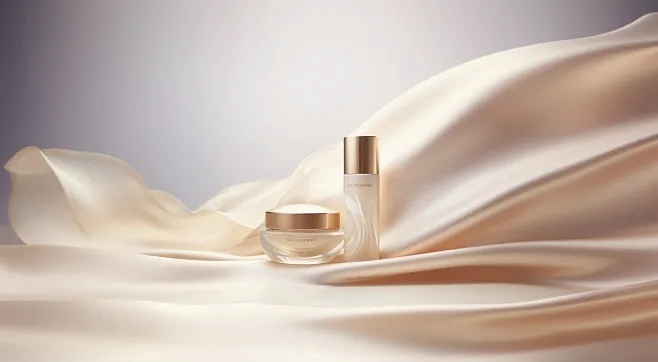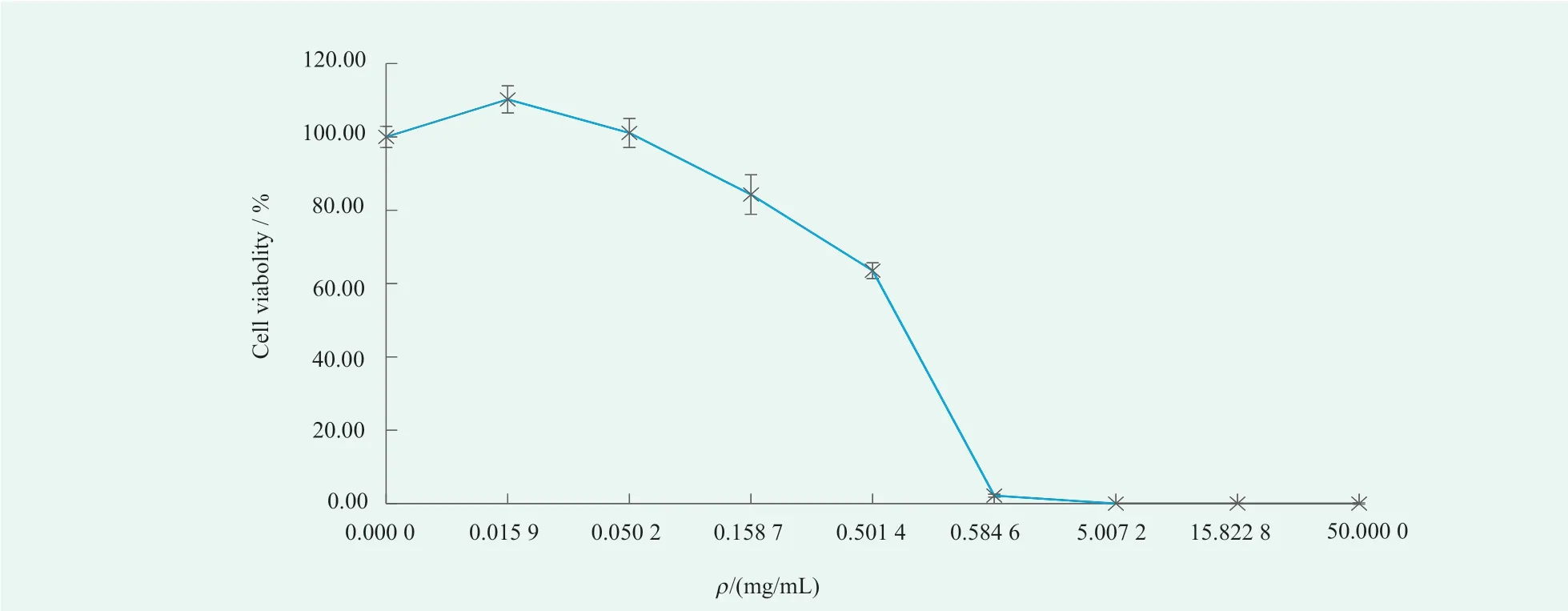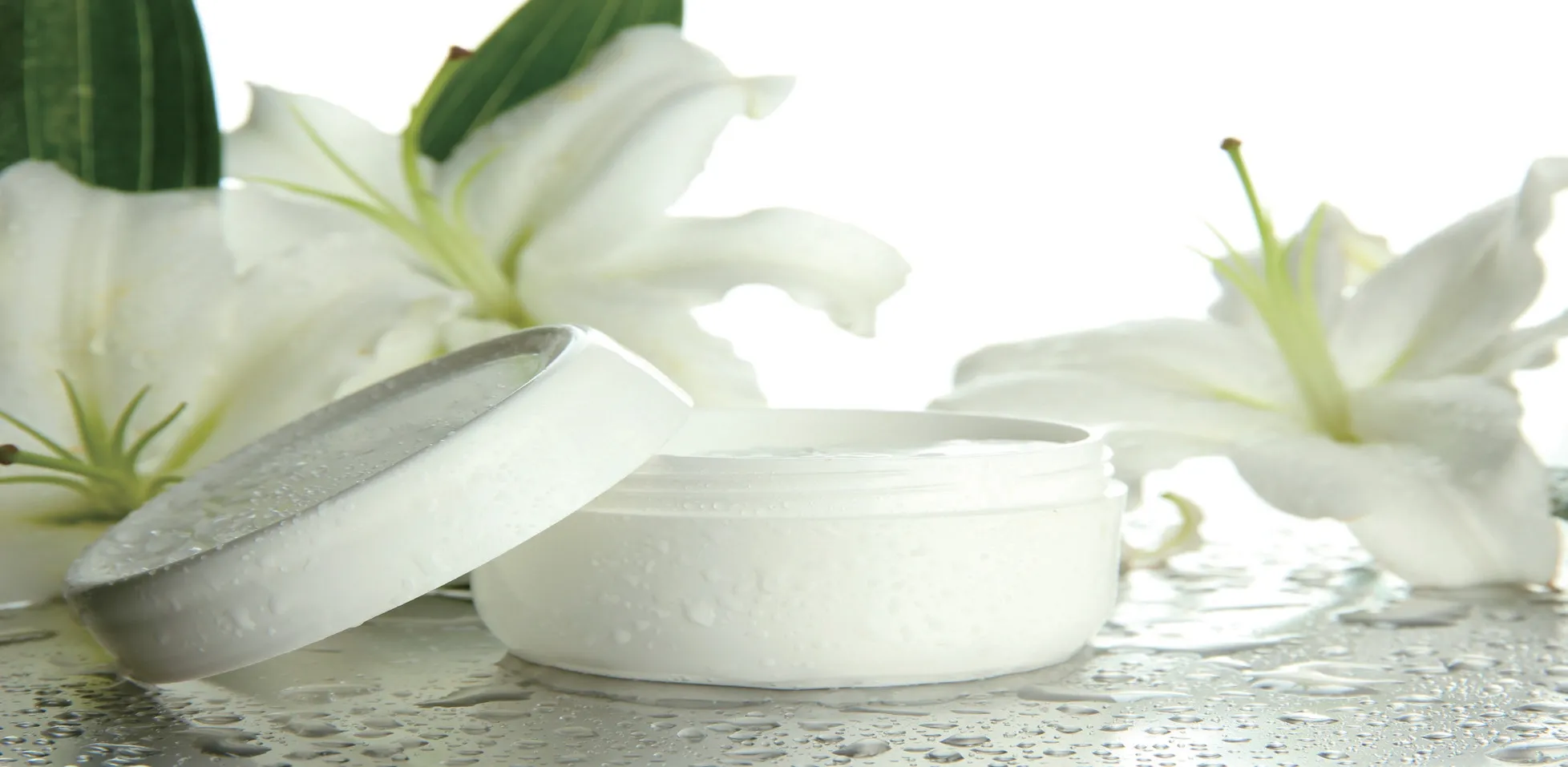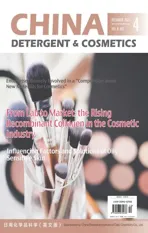In Vitro Study on the Soothing and Oil Control Efficacy of P-Hydroxyacetophenone
2023-12-17GuoShentaoXuWenfengNiuQiangZhangYuling
Guo Shentao,Xu Wenfeng,Niu Qiang,Zhang Yuling
Guangdong Youzhi Testing Technology Co.,Ltd.,China;
Long Yan,Peng Chunmei
Guangdong Bawei Biotechnology Co.,Ltd,China
Abstract p-Hydroxyacetophenone (p-HAP) was used as preservatives in cosmetics recently,their new efficacy was rarely reported.Here,We evaluate the soothing and oil control efficacy of p-HAP in vitro cells,providing a new efficacy basis for its application in cosmetics.The content of nitric oxide (NO),tumor necrosis factorα(TNF-α) and interleukin-6 (IL-6) were determined in LPS-induced RAW264.7 and lipid contents were determined in testosterone-induced SZ95.The results revealed that p-HAP attenuated pro-inflammatory cytokines,such as NO,TNF-αand IL-6 (P<0.01).Simultaneously,0.05mg/mL of p-HAP also inhibited the formation of lipid droplets in human sebocytes,with 17.64% of inhibition (P<0.001).These findings may be beneficial in the application of p-HAP as an efficacy ingredient in cosmetics,which may have a soothing and oil control efficacy according to the inhibition of pro-inflammatory cytokines and lipid contents.
Key words p-Hydroxyacetophenone;soothing efficacy;oil control efficacy;cosmetics
p-Hydroxyacetophenone (p-HAP) is a natural plant extract with the effects of normalizing gallbladder to cure jaundice[1],heat relief and analgesia,[2]Promote bile secretion and reduce blood lipid.[3,4]It is also an important fine organic chemical[5]and can be used in producing spices.
Skin irritation is mainly caused by the increase of capillary permeability and secretion of mucosal glands after the destruction of skin barrier,which often accompanied by skin swelling,itching,plaque and other phenomena[6].With the destruction of the skin barrier,various stimulants induced the release ofinflammatory factors such as IL-6,IL-8,and TNF-α from keratinocytes,which triggered the skin immuneinflammatory response[7,8].Research had found thatp-HAP may reduce oxidative stress and cell apoptosisin vivo and in vitro through the NF-kB signaling pathway[9],suggesting that it may have the function of inhibiting inflammatory responses.Oily skin was caused by excessive secretion of sebaceous glands and dysfunction of the sebaceous glands in the human body,while TNF-α could promote the synthesis of sebum through the JNK and PI3K/Akt pathways[10].Due to the anti-inflammatory effect ofp-HAP,it may also have the effect of inhibiting skin oil synthesis.
At present,p-HAP was often used as a preservative in cosmetics,[11]and had low risk of skinirritation,eye irritation,and skin sensitization under a safety concentration[12].Due to its absence from the list of preservatives specified in the “Safety and Technical Standards for Cosmetics”,it was labeled as an antioxidant in the formula actually.However,the other effects ofp-Hydroxyacetophenone in cosmetics have yet to be scientifically proven.The aim of this research was therefore to explore the functions ofp-hydroxyacetophenone in soothing and oil control through an in vitro cell model,providing data support forits application as a functional ingredient in cosmetics.
1 Materials and methods
1.1 Materials
Mouse mononuclear macrophages,RAW264.7 cell line,was obtained from China center for type culture collection (CCTCC).The immortalized human SZ95 sebaceous gland cell line,was obtained from Shanghai Medical College,Fudan University (SMCFU).DMEM,fetal bovine serum,Trypsin-EDTA,Gibco,USA.Lipopolysaccharide (LPS),MTT,DMSO,Nile red,griess reagent,testosterone,were obtained from Sigma-Aldrich,USA.TNF-α Elisa kit,was procured from Abcam,England.IL-6 Elisa kit,was procured from Wuhan Huamei,China.p-HAP was obtained from Guangdong Bawei Biotechnology Co.,Ltd.
1.2 Method
1.2.1 Cell cultrue
Raw264.7 and SZ95 cells were routinely maintained in DMEM respectively,containing 10%heat-inactivated FBS,at 37℃ in 5% CO2incubator,and experiments were taken after 24~48 h incubationin 96-well plates.
1.2.2 NO,TNF-α and IL-6 production in LPS -induced RAW264.7 Cells
Referred to the group standard methods,[13]Raw264.7 cells (5 × 104cells/well in 96-well for 24 h incubation)were stimulated with LPS (1.25 μg/mL) in the presence or absence of p-HAP for 24 h simultaneously.Nitric oxide production was measured by Griess assay,and the levels of IL-6 and TNF-α in the cultured medium of Raw264.7 were measured using an IL-6 or TNF-α ELISA kit,performed according to operating protocol of the kit.Dexamethasone sodium phosphate was used as positive control(PC),the medium with or without LPS were used as negative controls (NC) and blank control (BC).For griess assay,50 µL of culture medium was incubated with 50 µL Griess reagent for 10 min in darkness.The production of NO was determined by measuring optical density at 540 nm.NO production by individual LPS stimulation was designated as 100% for each experiment.NO relative content was calculated as follows:
NO relative content (%)=Asample/ANC×100
Where ANC and Asample were the absorbance of NC and Sample,respectively.

1.2.3 Cell lipid accumulation in testosterone-induced SZ95 cells
SZ95 cells (1×105cells/well in 96-well for 24 hincubation) were stimulated with testosterone in the presence or absence ofp-HAP for 24 h simultaneously.Dexamethasone sodium phosphate was used as positive control(PC),the medium with or without testosterone were used as negative controls (NC) and blank control (BC).After incubated,discarded the culture medium,the cell were incubated with 100 µL Nile Red working solution for 20 min in darkness at 37 ℃ after washed once with PBS,and detected the fluorescence intensity at ex/EM=485 nm/565 nm.
Oil inhibition rate (%)=(MFINC-MFIsample)/(MFINC-MFIBC)×100
Where MFINC,MFIBC and Asample were the fluorescence intensity of NC,BC and Sample,respectively.
1.2.4 Statistical analysis of the data
A t-test was used to compare statistical differences between experimental and control groups for cell experiments.Ap<0.05 was considered statistically significant.
2 Results and discussion
2.1 Soothing evaluation by LPS -induced RAW264.7 Cells
Inflammation is an essential immune response that enables survival during infection or injury and maintains tissue homeostasis under a variety of noxious conditions[14].Using LPS to induce acuteinflammation in Raw264.7 cells,we found that the NO,TNF-α and IL-6 production were significant increased(P<0.05) compared to BC.0.001 mg/mL ofp-HAP significantly reduced LPS-induced IL-6 production,with the increased concentration ofp-HAP,the level of IL-6 decreased.In addition,0.1 mg/mL of p-HAP significantly reduced LPS-induced NO and TNFαproduction compared to NC (P<0.01),while had no significantly reduced in 0.01 mg/mL and 0.001 mg/mL(Table 1).

Table 1.Effects of p-HAP on NO,IL-6 and TNF-α in LPS-induced RAW264.7
Sensitive skin (SS) was prone to subjective symptoms such as burning,tingling,itching,and tightness when stimulated by physical,chemical,and psychological factors,with or without objective signs such as erythema,scales,and telangiectasia.[15]Inflammatory response was a self-defense mechanism of the skin in response to external stimuli,and the levels of related inflammatory factors could significantly increase after skin stimulation[16].Chang Ching-Wen et al.[17]found thatp-HAP inhibited the production of NF-κB,cyclooxygenase-2(COX-2)and nitric oxide (NO),reduced the levels of TNFα,IL-1b and IL-6,and reduced the formalin-induced licking response,and this analgesic effect may be attributed to its anti-inflammatory effect.In this study,the production of NO,TNF-α and IL-6 significantly reduced byp-HAP were also found,indicated thatp-HAP has a soothing effect in cosmetics combined with the mechanism of skin irritation and the definition of the soothing effect of cosmetics.
2.2 Determination of cell lipid accumulation
Oily skin is caused by the excessive secretion or dysfunction of sebaceous glands in the human body.Abnormal secretion of sebaceous glands often leads to skin problems such as acne.The oil control effect of cosmetics refers to helping to slow down the secretion and deposition of sebum at the application site,or making the phenomenon of oil production at the application site less obvious[18].Sebocytes were the site of skin sebum synthesis,and inhibiting the sebum synthesis was the most direct pathway for oil control.
Using testosterone to induce sebum synthesis in SZ95 cells,we found that the cell viability ofp-HAP was 101.09% at 0.05 mg/mL,which indicated thatp-HAP had no cytotoxicity to SZ95 at this concentration.0.025 mg/mL or 0.05 mg/mL ofp-HAP significantly reduced(P<0.05) the sebum synthesis compared to NC,the oilinhibition rate were 16.58% and 17.64%,respectively.Result showed thatp-HAP significantly inhibited the cell lipid synthesis in sebocytes (Figure 1 &2,Table 2).

Figure 1. Cell viability of p-HAP in SZ95 human sebocytes

Table 2.Inhibition of Lipid in SZ95 human sebocytes treated with p-HAP

Figure 2. Effects of p-HAP on lipid accumulation in SZ95 human sebocytes
The lipid film formed by sebum not only protects the skin by providing resistance to pathogens and ultraviolet rays,but also protects the skin surface from dehydration and oxidative damage[19,20].However,when sebocytes were stimulated by inflammation and other factors,lipid synthesis increases,leading to excessive sebum production,which was a key factorin the development of acne[21].Acne vulgaris is a highly prevalent inflammatory disease of the skin[22],more than 85% of adolescents were affected and may develop the disease into adulthood[23].Four factors play vital roles in acne pathophysiology: hyperseborrhea and dysseborrhea,altered keratinization of the pilosebaceous duct,Cutibacterium acnes (C.acnes)and inflammation[24].p-HAP was an effective preservative that can meet daily anti-microbial requirements in cosmetics practically[25,26],the research found thatp-HAP reduced the levels of NO,TNF-α and IL-6,inhibited the cell lipid synthesis in sebocytes,which inferred it could used as a functionalingredient with anti-acne activity in cosmetics.
3 Conclusion
p-HAP significant reduced (P<0.01) the levels of pro-inflammatory cytokines,such as NO,TNF-α and IL-6 in LPS -induced RAW264.7 Cells,inhibited the cell lipid synthesis in sebocytes.These findings may be beneficial in the application of p-HAP as an efficacy ingredient in cosmetics,which may have a soothing and oil control efficacy according to theinhibition of pro-inflammatory cytokines and lipid contents,the several effects also inferred it could used as a functional ingredient with anti-acne activityin cosmetics.

杂志排行
China Detergent & Cosmetics的其它文章
- The Haircare Efficacy Research of Prinsepia Utilis Oil
- Study on the Antibacterial and Deodorization Effect of 4,4-Dichloro-2-Hydroxydiphenyl Ether in Laundry Gel Beads
- Study on the Effect and Mechanism of Green Plum Citron Double Strain Fermentation Filtrate on Skin Barrier
- In Vivo Study of a Natural Whitening Agent
- The 3rd Summit Forum on Amino Acid Surfactant was Held
- The 2023 (12th) National Sulfonation/Ethoxylation Technology and Market Seminar was Held
